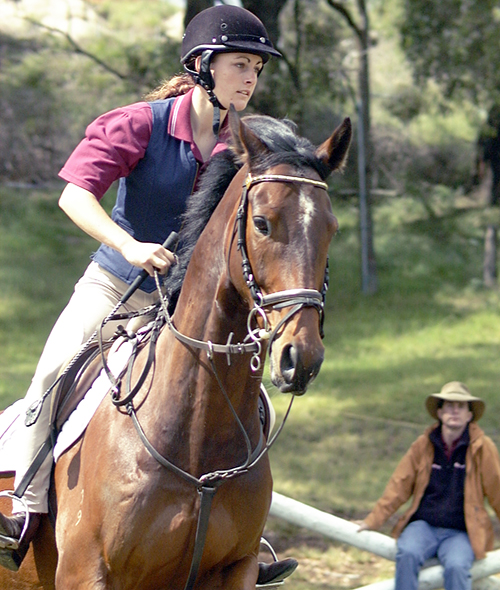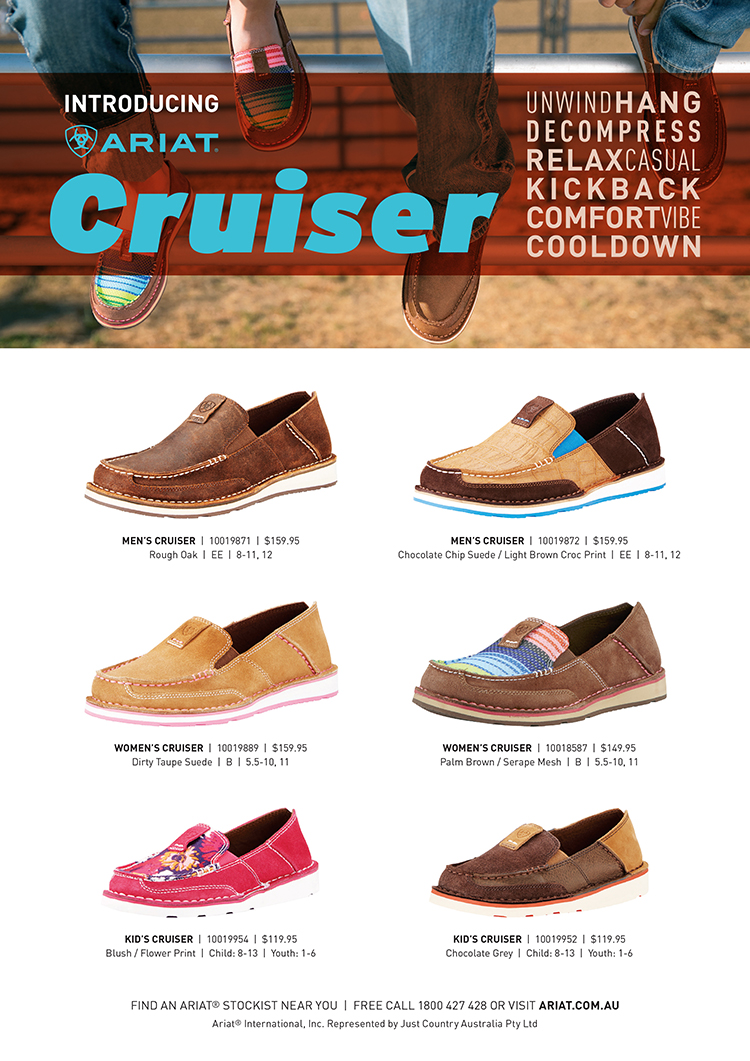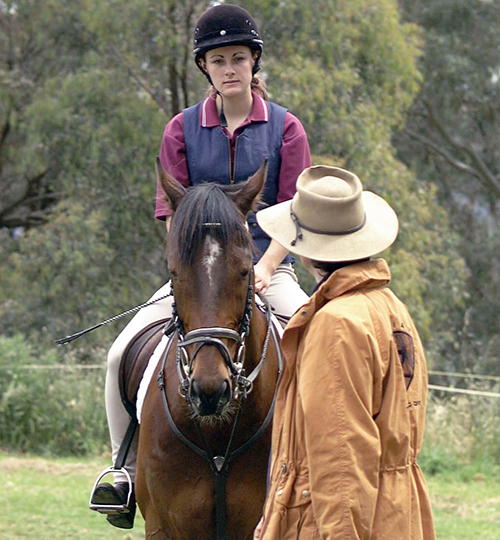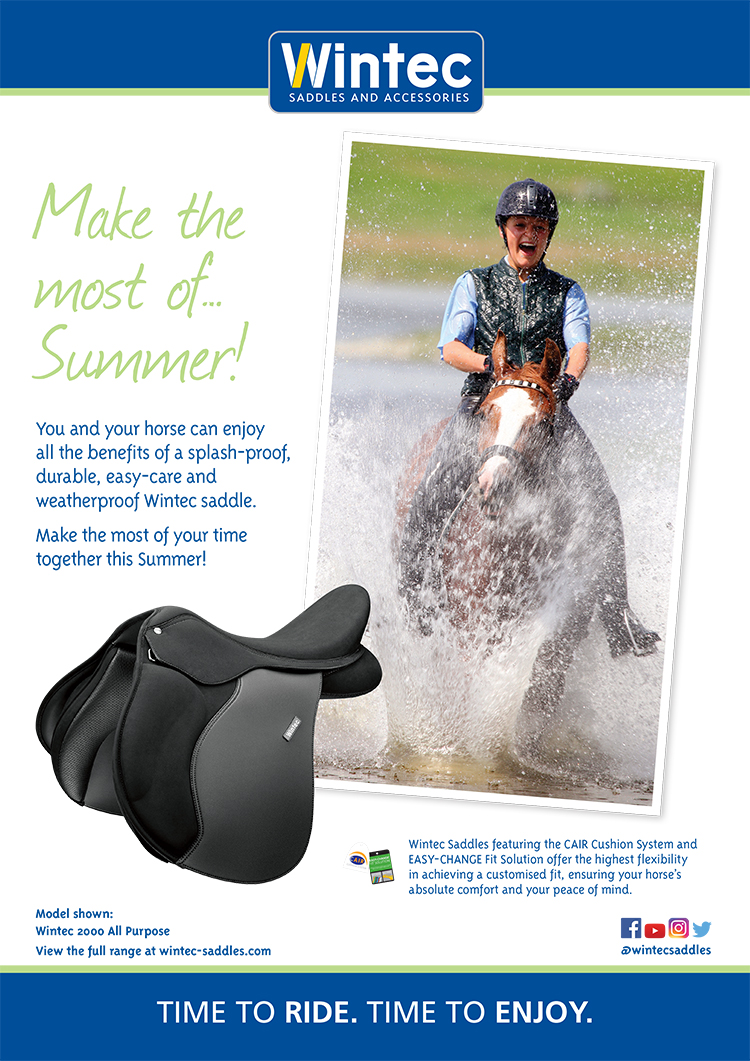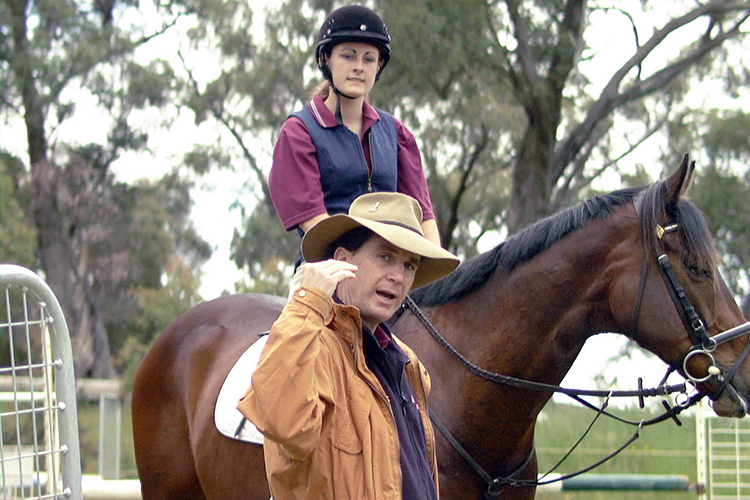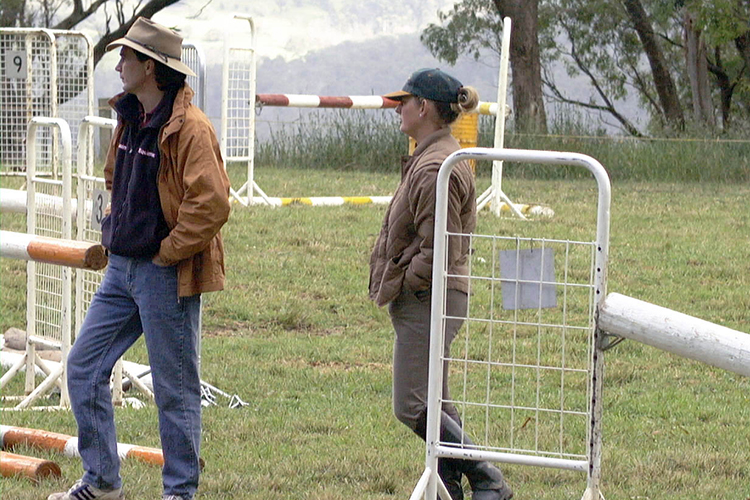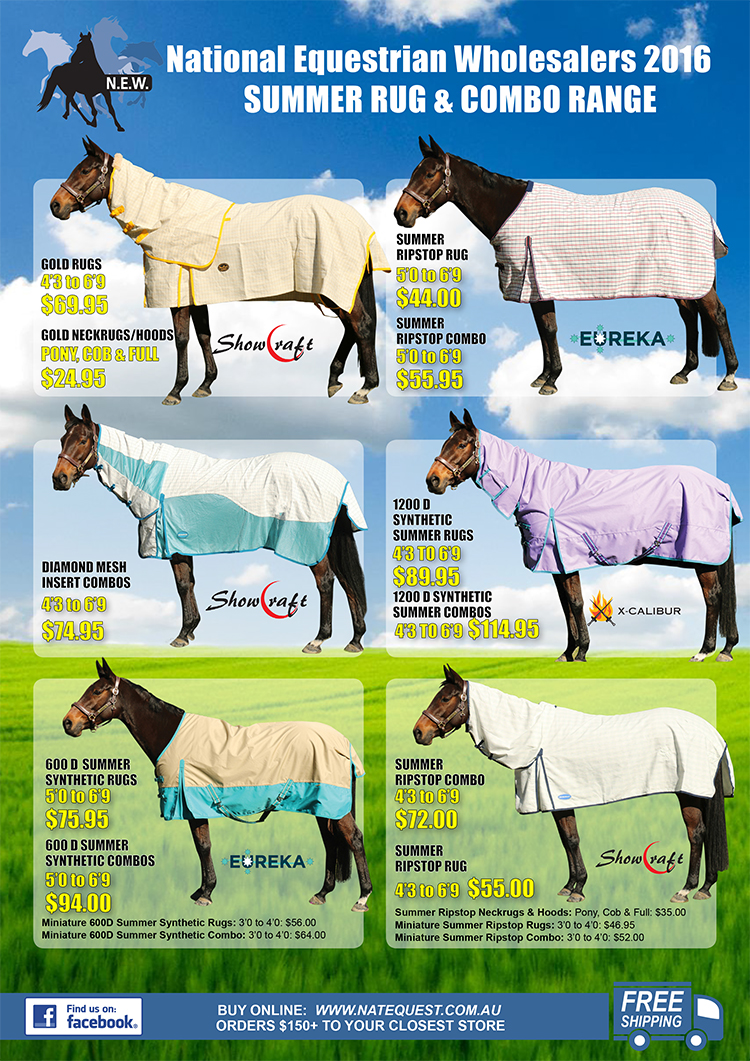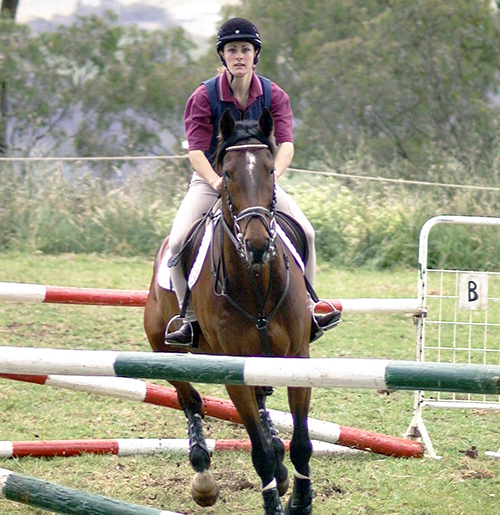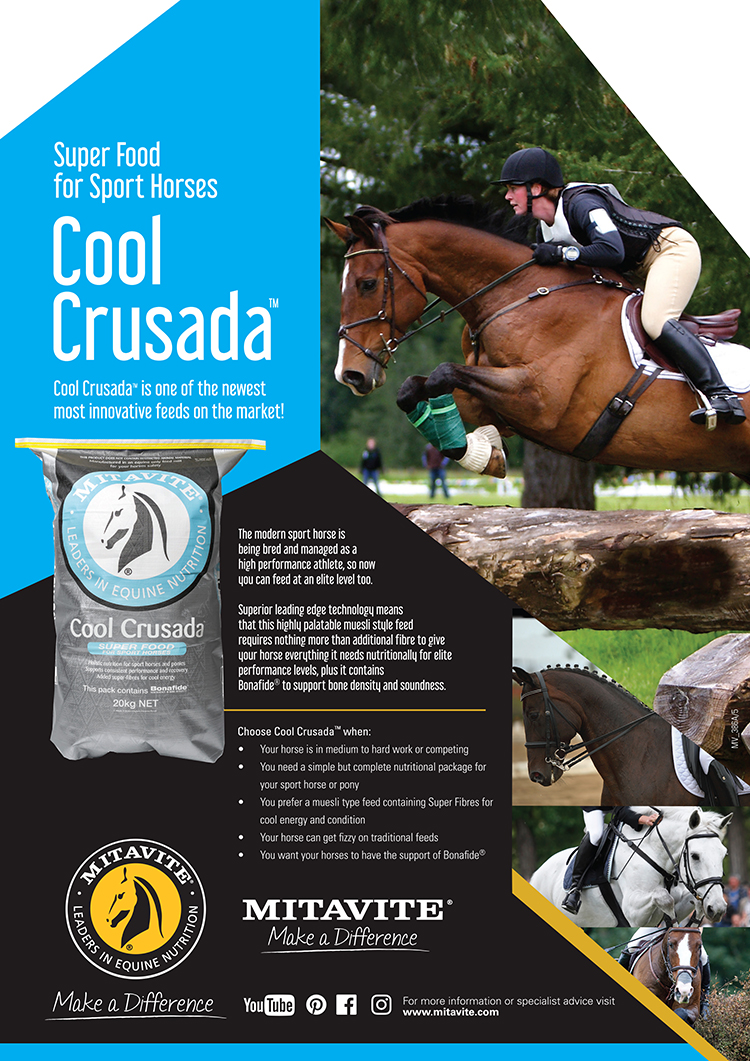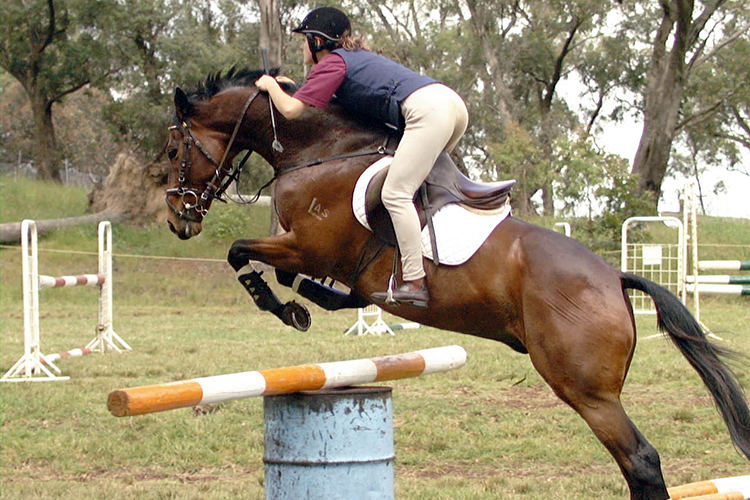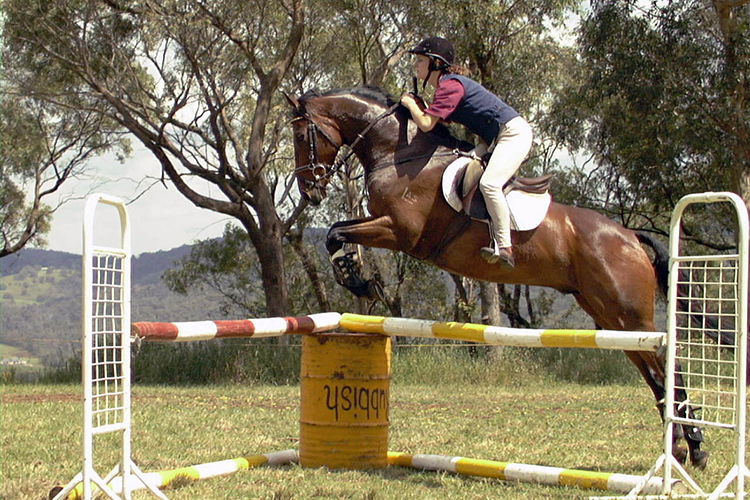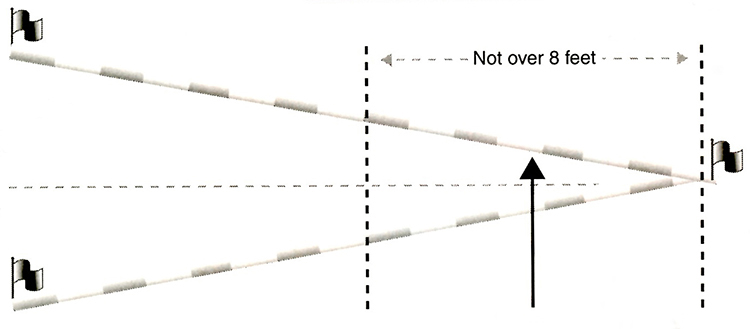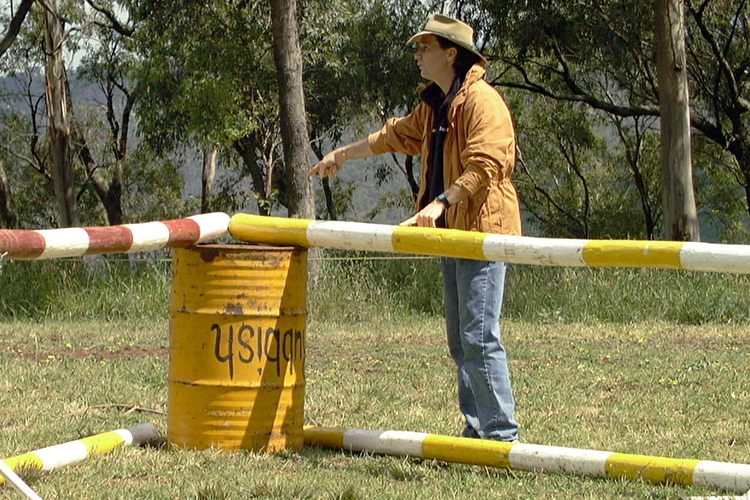The year 2000 was when Matt Ryan collected his second Olympic team gold medal, to go with the individual and team medals he had won at Barcelona in 1994. When Matt visited the THM office in Pakenham Upper, it seemed a good opportunity to put him to work, and make an article for the magazine…
Words and pix – Roz Neave
Jessie Fleming was a neighbour of The Horse Magazine at the time, and was delighted to have the opportunity to train with Matt.
On the morning of the lesson, Jess rode around to the Pakenham Upper Riding Club Grounds. When Matthew and I arrived, we were met at the gate by another Horse Magazine neighbour, and Jess’ instructor from age eight, Sam Hodges (now Bartlett).
Sam had been a pupil of Matthew at the NSW Equestrian Centre. It is a mark of her professionalism and dedication, that she had come to watch the session. This was not to a sit back and imbibe lesson, Jess was involved from the start.
“So tell us about some of the things you think about on the flat?” Matt asked Jess…
“With him, I hove a bit of trouble because he goes peacockish, so I bring him low and round to warm him up.”
“How do you get a horse round? Before you get a horse round and low, what do you have to think about doing? How do you get the horse on the bit, round, same thing…’’
(Article continues below)
“Ride him forward?”
“Yes, that’s the magic word I was looking for. Forward, they must be forward if you are going to have any chance of getting the horse on the bit. Sometimes I liken it to flying a kite, when you go kite flying what’s the first thing you need? Wind, you need a good healthy breeze. When you’ve got a good healthy breeze, then you can hold on to the string of your kite. That’s a bit like asking a horse to come on the bit. There’s no point in taking up a contact and asking the horse to come on the bit, if you’ve got no forwardness. No point in trying to fly a kite if there’s no breeze. So think about that string as being your rein, and you need that contact in the rein to get the horse on the bit just like you need to hold onto the string to fly the kite, but you still need the breeze, and you need the forward to get your horse round. Make sure you’ve got the forward and then that will allow you to take the contact, and ask the horse to become rounder and stretch lower. What else do you look for?”
“Rhythm.”
“That’s very much related to forwardness, as long as your horse is forward, generally you tend to have a good rhythm. Sometimes a horse will go a little unlevel, not necessarily because they are sore. Why might they go unlevel?”
“They are not pushing through to the contact?”
“OK. Sometimes they can be more unlevel one side or the other. Why?”
“Because of stiffness?”
“Yes spot on, and 90% of horses are stiffer on the right. Most horses are left handed. You’re getting all the right answers, someone must be telling you something correct. Most horses are left handed, so we always work on their good side first, warm up on their good side at least. Quite often horses will go to the point where they are a little uneven or unlevel, and that’s what we call bridle lameness. The horse goes unlevel, not because they’re actually sore, but because they’re not swinging through the back and particularly on that right rein, not getting that inside hind leg to come up and use itself as much as the left hind leg, they get a bit short behind in the right and they go a little unlevel. You see it in dressage tests, a horse goes unlevel in a 10 metre circle. Quite often the rider feels the horse go unlevel and pulls it up and says, ‘oh my god, my horse is lame’. And it’s not true, it’s just that the horse isn’t working properly through the back, or he finds it more difficult, particularly on the right rein.”
“So warming up, getting the horse stretching low is good, because you’re working on those back muscles, those rump muscles. It’s particularly important when you’re you can get your horse to stretch low, you’re preparing him to use himself to work straight up. Horses learn better when you ask for engagement through repetition, and that’s why event horses need some collected work.”
“What else do you do in your warm up?”
“Ride circles and change the bend.”
“Yes, changing the bend that’s good. If you look at an ordinary athlete, you see Cathy Freeman bend this way, and bend that way, so changing flexion is very good. In a dressage test, quite often we do serpentines. Serpentines are a good suppling exercise because the horse bends this way, and bends that way.”
more below
‘When we’re warming up, we don’t always just change direction, we bend the horse through the neck and the poll without moving off the circle line. It’s a good exercise, even though it doesn’t make sense sometimes when you’re going to the left to have right bend you want to have that capability. Obviously when you’re competing, you don’t have outside bend, but you’d like to be able to do it, to have that capability of bending the horse away from the shape of the circle. Then back again, bending the horse is a good flexion exercise.”
“Bending and suppleness are two great qualities, but there’s one that happens before that and it’s called confidence. With everything that you do with horses, you don’t want to put so much pressure on the horse that you actually frighten him. Always be careful that you don’t ask more than what they can mentally handle.”
“Sometimes a horse is going to be a little nervous, a bit frustrated or confused, that’s fine, that’s all part of the learning curve. If you do something that they’ve never done before. It’s going to be puzzling to a degree, and they’re going to get nervous and tense. That’s not a problem, but you don’t want to push that tension, or pressure them to the degree where it blows their brain.”
“I’m sure the first time that you go sky diving or rock climbing, you’ll be nervous, but as long as your instructor is telling you the right things, and telling you what to do in which circumstances, you’ll have a go at it. It’s different with different people – some people thrive on pressure. Put some people in a big competition and they do their best, put them in an ordinary competition out in the sticks, and they don’t actually do so well. Characters are different and that will also vary with the horse.”
“So that first quality of confidence, we need to look at we don’t want to blow the horse’s brain. It’s particularly important when you’re doing something new, don’t imagine it’s going to work just straight up. Horses learn through repetition, and that’s why event horses especially, don’t reach their peaks until mid-teens. That’s because they don’t need always to be the most powerful, they need to be the most learned. They become the most learned through repetition, through experience. So to go back through all of that, there are three qualities I work on: confidence, forwardness, and roundness. When you’re schooling on the flat, they’re the three qualities you work on. How do those three qualities apply to jumping? Let’s start with the first, confidence.”
“You need to have confidence in your horse??”
“We’re talking about the horse here, forget about the rider.’’ ( Matt’s laughing).
“The horse needs to have confidence to get over the jump?”
“When we ask the horse to do too much, have you heard the term over-facing? That’s when we over-face the horse with a question they’re not ready for, and you think they’re ready for, and they crash through it, and it gives them a hell of a fright. Then the horse’s education goes backwards because they become so worried about that particular fence, and not only that particular fence. The situation normally comes from the fences being just a bit too big, and the horses not being controlled enough in the approach and getting the approach wrong, and then crashing through the jump. That’s when horses start losing confidence. So that first quality still stands up, now forwardness.”
“If they are not forward enough they can’t get off their hindquarters to get over the jump?”
“OK. Sometimes I liken jumps to hills, and you’re coming up this hill in a car, and when you come up a hill in a car, what do you have to do? Do you drive? You’re learning to drive?”
“I had my first lesson last night”
“What do you do when you come to a hill?”
“Put the accelerator down?”
“Absolutely, you create more revs. If it’s not a very steep hill you hardly have to touch the accelerator, but the steeper the hill the harder you have to put the accelerator down, to create more revs. With little jumps like this cross rail, you don’t have to have many revs, but as the jumps get bigger, you have to have more revs. That doesn’t mean you have to go faster, because you can always change down a gear, like going up a very steep hill, you don’t keep the car in fourth or fifth gear, you bring it down to third or second, and the important thing is you create more revs. When you bring it down to second, wmmm, the engine actually revs up higher, it gives you more torque. So if you come to a big fence, and it’s upright, you don’t want speed, but you still have to have energy, so you shorten up, put the horse back to second gear, but you still create revs. So that’s where forwardness comes into play when we’re jumping. The bigger the fences you’re jumping, the more revs you need. The more educated the horse, the shorter you can get him, the better the lower gears are. With the greener horses that don’t collect or engage very well, you have to use a certain amount of pace, but still keep those revs up.”
“Roundness, how does roundness come into play?”
“So they can bascule over the fence?”
‘’Yes, good. The rounder your horse is willing to be, the rounder he is in the approach to the fence, the better the jump is going to be. Then they tend to be neater in front, and looser through the shoulder, that’s what it feels like. The roundness allows them to be softer all over. It will allow them to be tighter in front, not all horses are great with their knees, but the softer they are, the more they tend to draw their knees and their shoulders up, and the bigger they will be behind as well. If ever you see a horse hit fences or roll rails with their back legs, it’s a sign that they’re hollow. So how do we allow the horse to bascule over the top of the fence?”
“Put your hands forward?”
“Yes, the reason I asked that is because quite often when you see horses roll rails with their hind legs, it’s because the rider has hung on too much on the top of the fence and hasn’t allowed the horse to round or bascule. What else does roundness give the horse?”
“Easier turning, because they’re more underneath you, and you’ve got more control?”
“Good good. Sometimes I liken getting a horse properly on the bit, to getting out of a little Mini into a Porsche. It gives you so much more to play with: it gives you power steering, it gives you extra gears, it gives you a turbo engine, it gives you four disc brakes instead of two drum brakes, it gives you so much more control. And getting back to the bigger engine, that is to do with the horses using themselves, the rounder the horse, the more the horse engages itself, and that leads to collection, and that gives the capability to shorten in front of the fence, and still keep your revs. A horse that doesn’t have that roundness finds it much more difficult to keep the revs when you shorten. Instead of relying on speed to keep your revs, you can shorten the horse up into a lower gear, and still have your revs. That gives you such an advantage over people who don’t do much flat work.”
“So you should encourage roundness, even get the horse’s head carriage a bit lower in front of the fence, because that gives them the capability of bending, of engaging, of coiling. If you ever see a slow motion picture of a tiger or a lion coming to its prey, he lowers and coils before he springs. If I was a high jumper and I was coming around the corner to do the Throsby flip, I come around the corner, and on take-off I’m lowering, I’m coiling and then I throw myself over. Be careful, don’t think because horses have to jump up, they have to have their heads up. The best chance you can give a horse to jump up, is by allowing the horse to coil.”
“It’s like a medium trot, the feeling you should have, is that you allow the horse to lower and lengthen, but you don’t drop the contact. It’s almost identical in the approach to a jump. You don’t want to drop the contact, because that contact can help you contain and manage the horse. You must allow the horse to lower just in front of the fence so he can coil and then as the horse jumps up, you continue forward with your hands to allow him to bascule.”
“OK confidence, forwardness and roundness, are the three qualities I drill into my riders, as far as the horses are concerned. Once we’ve got that sorted out, we start talking about your own body position. We’ll start on that once you start jumping. Go and warm up around the arena, walk, trot and canter for 5 or 10 minutes, I’ll make a few comments while you’re doing that.”
(More below)
Poor Jess, after Matt’s grueling cross examination, it must have been a relief to just get on Thady and ride… if you have the feeling that Matt Ryan is a pretty demanding teacher and Jess’ jumping lesson might be pretty concentrated. It was…
Jess started tackling some small warm up cross rails, and Matt was in action…
“When he puts his nose out try not to fall into the trap of just trying to control it with hands. There will always be times when the hands have to do a lot, but they should always be backed up with leg. Never should the hands over-ride the leg. Whenever a horse resists your hands, think forward, go forward. Now if you are already forward, that’s fine, but too often we make corrections merely with the hands, and forget about using the leg. Keep the horse forward and remember forwardness comes before roundness.”
“If the horse throws his head up on the approach to a fence, that can create problems. He’s not wanting to accept true roundness, so he’s snatching at the bit, sometimes I suggest to leave it alone. If leaving it alone still creates the problem of charging, we’ll have to reassess the situation.”
And always the rider as well as the horse was under the spotlight:
‘’I’m looking at your position. Is the lower leg staying forward? If I’m thinking of a dressage position, I’m thinking, shoulder, hip, heel, in other words, I can see the girth. Come jumping, I don’t want to see that girth. Some of the cross country fences, I want to see the girth behind the leg. That’s where the leg should be if you are going down a drop into water, or approaching a slope down a hill. Today, I do not want to see that girth, keep that girth covered up. To do that, think of your weight down through the heel and straighter through the knee. Don’t think of gripping with any of your leg, think of all your weight going down through your heel, and bouncing on your feet”
‘’If you start gripping, then you are starting to rely on your strength, and if muscle strength had anything to do with being a good rider, the men would wipe you women clean. Men are naturally stronger, but that’s not what makes a good rider. A good rider is someone with balance, feel and sensitivity, so don’t try and compete with men as far as being strong. Sometimes men can cut comers with younger horses, but the people who are top riders are the people who develop other skills.”
“Look at who won the Four Star at Adelaide, and even second, two girls. The girl who won, is a piddly little girl, a really little girl and she won the Four Star. It doesn’t take muscle to be the best rider. So try not to think of gripping, that’s working on the wrong tack, and then you’re missing some of the other things you should be working on. So balance, weight down into your heel, weight down into your feet, and into your stirrups. The lower leg stays forward, I call it my seat belt. Whenever you hop in a car, the first thing you put on is the seat belt Why? If ever something goes wrong, you don’t want to fall forward and hit the windscreen. Whenever something goes wrong with a horse, and you fall off or lose your balance, which direction do you go?”
Forward.
“Yes, you always lose your balance forward. You might not fall off, you might hang on round the neck, how often have you smacked your nose on the horse’s mane? So the lower leg being forward acts like a seat belt, you brace against it. Like a seat belt, it doesn’t guarantee your safety, but it gives you a better chance of surviving a rough moment when your body might be thrown forward.’’
“Think of your upper body like a shock absorber, as the horse goes up over a jump, I want you to fold. As you approach the fence, I want you upright, the natural tendency is to lean towards your fence, as you are coming in. But if you’re leaning towards your fence, it’s quite often where something goes wrong. The horse stops or spooks and if you’ve already started leaning forward, it puts you in a position w here it’s so much easier to lose your balance.”
“When I ride my fences, I imagine something might go wrong at any split second. No matter how experienced or how good my horse is, I’ve got to be prepared for something to go wrong. Even if it’s not the horse’s fault, even if it’s just a slip on a wet day, be prepared for that. If a horse does slip, or a snake goes past a fence, be in a position where you can cope with it. Be upright, so you don’t lose your balance.’’
“Only as the horse jumps up, do I want you to fold, and I’m talking about folding at the waist. When you fold, try not to think of leaning towards the horse’s neck, think about your chin going towards the horse’s with so it becomes more of a crouch. That way you don’t put yourself in front of your lower leg. If you lean too far forward, then you put yourself in front of your seat belt That seat belt is only effective if the upper body stays behind the lower leg.’’
“Most jumping saddles are pretty flat these days, they allow you to slide your bottom out of the saddle as you’re crouching. The high cantle is great for dressage when it snuggles you forward, but for jumping, the cantle tends to catch us and throw us forward if it’s too deep a seat”
“Don’t forget when the horse comes down the other side to unfold. As the horse touches down with his front feet, you should be upright for the next fence, if it’s a bounce, or if it’s a stride away or how ever many strides away.”
“If something goes wrong, you’ve got to be like a good doctor. The better doctor you are, the more likely you are to recognize the symptoms of some problem that your patients bring in, and give the right treatment. If the doctor doesn’t know what’s going on, then that patient could get to the point where it becomes a life threatening infection. You have to be able to recognise symptoms of something going wrong, and correct them, but you’ll only recognise the symptoms if you study them. Like that good doctor who studied his text books, you’ll only recognize a problem if you’ve thought about it.”
“So here’s the problem we are going to consider, let’s look at this combination for what could go wrong.”
It’s on a down hill slope and the horse could fall on his forehead?
“Yes it’s going a little bit downhill and it’s easy to let the horse fall on his forehand and not see a very nice spot, hopefully the fence is small enough that it shouldn’t be a problem, as long as you’re prepared. What I always say when you’re starting a course, is look out for ‘first-jump-itis’. What does that mean?”
The first jump on the course, you don’t seem to ride it so well.
“It’s pathetic sometimes, because it’s so small we think it’s just a give-me. The horse gets a surprise, neither of you are on the ball, so always appreciate that the first fence could cause a stupid stop.”
more below
I’ve done it before…
And just to make it worse, Jess’ Mum, Jo, and her instructor, Sam, remind Jess, that it was only recently that she had a first fence whoopsy… Luckily it would seem it has happened to Matt once or twice in his distinguished career.
“You swear and curse under your breath,and you feel like hitting the horse, and yourself as well, and you think, ‘I hope no-one saw that’. Well that’s first-jump-itis. OK, the second jump what about that?”
I’m approaching on a curve, and he mightn’t come into it straight.
“Good, that’s exactly what you did at the first warm-up cross rail.’’
(The first fence Jess jumped, she approached on a very unusual line, saw a bad spot, and Thady cat-leaped the fence, leaving Jess in a less than classical position. ‘What went wrong?’ asked Matt, ‘I’m stressed’, replied Jess).
“I think that you might be prone to that, not lining up fences, what are you going to be thinking after jumping the cross rail?”
Turn early, make a wider turn?
“Yes, stay out wider. Plan you turn (Matt gave specific markers, other jumps in the arena, for Jess to plan her line around), don’t just skim around the corner, stay out and give yourself time to get nice and straight. Give the horse time to see what you are jumping. What else could happen?”
It’s a different type of fence, it’s bright…
“Yes, and remember everything else we’ve done so far, you’ve ridden past that fence, so he might be assuming you’re going past it again. When you turn him to it, he might think oops, she’s got this wrong, I should be going around it, he might spook a bit. Not only do you have to give yourself room for that turn, but be a little aggressive, it’s only a little jump for sure, but it’s different and he might not be expecting it. If he’s going to run off, which way will he go?”
My horse would most likely run off left.
“That’s good to know, if your horse drifts left, be aware of it. Don’t over correct it, be aware of it. At the hint of a drift to the left, correct it, don’t let it wobble out of control.”
The next fence is airy, it’s got no filling in it, and sometimes that can be a little ugly. Don’t take it for granted because it is a little fence, be suspicious of it. He might spook at it. Then you come to a combination – what do you have to be careful of here?”
Straight lines.
“Good, create a straight line, work out the line so when you jump the first one you are lining up the second one perfectly. When you are at a competition, watch other people go, so you can see the striding.’’
“You must try not to think that you have to accelerate those last two strides to a fence. The canter you start the course with, should be exactly the same canter you have when you approach the jump. You are tending to ride, careful – careful – then go at the jump. Try not to push a horse out of rhythm. Sometimes you are going to have to hold a horse in front of a fence, but if you have let him get into the habit of riding harder the last couple of strides, then it gets into his brain that he has to charge a bit. Think of your rhythm, make sure that the rhythm you have a hundred metres away is the same as the rhythm you have on take off.”
The next exercise consisted of two angled show jumps -“I am not a showjumper and I don’t enter speed events, so why would I practice angles at my showjumps at home?”
To practice for cross country?
“Right, that’s what we are doing with the showjumps, trying to create the problems we find cross country. The better I am at angling fences, the quicker I will be cross country. If you work on the direct route, then you are saving time, and time is so crucial in cross country. Sometimes it might just be an individual fence out by itself- and if you are used to angling fences, then you can come straight across the line and save two seconds either side of a jump. If you do that half a dozen times on course, then you are looking at saving 25 to 30 seconds, and that is a hell of a lot of time when you think about it. You can be quicker cross country without being faster – and it is the speed which becomes dangerous. If you and the horse become comfortable at angling the fences, you can become so much more effective making time cross country, and still be safe. Quite often in the learning process, because you are angling the fences, you’ll have more runoffs than most people, but as long as that doesn’t put you off, keep on working at it, then the horse becomes so accustomed at angling fences, that it is not a problem. That’s why I do these exercises.”
Jess’ first attempt at an angled exercise was a bit of a disaster, with Thady running out – “Where the hell did that goddamn line come from? Why did you throw away the line we were working??”
I was stressing.
“Okay, let’s have a look at what happened. If you never tell the horse that running out is naughty, then they will develop a history of running off and they will never get better. You’ve got to say ‘no that is not on’ – but at least give yourself a better chance at the fence. Where that line came from, I don’t know. Ugh.”
“You have to work on problems – work on the water, work on the ditches. You need to make him so familiar with angling a fence where he could run off to the left, but you don’t let him, so that it never becomes a problem. It might always be a little bit of a problem, but you try and make him so familiar with those angles, that you never mind the risk.”
“Horses learn through repetition. You don’t stop when they have done the exercise once correctly, they learn through repetition, keep going until they are familiar and comfortable with it.”
The next exercise was jumping a 44 gallon drum with a rail on the top, it went quite well.
“He did it fluently the last three times, and that leaves a nice taste in his mouth, I’d like to come back in a couple of days time, and hopefully he’ll pick up where we left off. The other thing you can gradually do is reduce the top rail to a small rail, but when you do that, put the ground rail back – then take the ground rail away. Start mixing it up. Sometimes you start by putting wings on the drum. Leave your short rail there, and have a rail for a wing each side. Gradually increase the angle of the wing. Sometimes when we jump arrowheads, what worries the horses are the wings that go back from it – so we simulate that by putting rails off to the side. At the end of the day you would like to be able to jump that little barrel by itself, or at least that barrel with just a little rail on top.”
“Moving on from the barrel to an apex, how do you work out where to jump?”
You jump it on the narrow end a bit?
“You can’t say that, there is this rule we should apply – look at how far you can go on each side of the jump, from one flag to the other. With this jump, you work out the maximum you can go each way, then cut it in half. Then you have to work out where do you jump.”
“You should imagine that there is a rail going straight down the middle, bisecting the angle of the apex. It is an imaginary rail that you jump straight on. Don’t jump the first of the apex straight on, don’t jump the second straight on, you jump the imaginary bisecting rail straight on, so a fraction of an angle here, and a fraction of an angle there, and in the middle of your maximum one way, maximum the other way. The temptation with apexes is that you come in, and as you said, try and jump to the narrow end of it, that’s why there are so many runoffs at apexes, because they are not analysed enough. You shouldn’t be jumping the narrow end, you should be jumping in the middle. This is where you should be aiming at, and it is an imaginary rail you should be aiming at, that is straight So if you come to an apex like this, it is very important to go back when you are walking your course, and look at your line, and normally you look for something in the distance to line up.”
“Let’s go back. We are going to line up that yellow patch on the next jump, and that’s what we are virtually jumping. That’s the sort of thing you’ve got to look for when you are walking your cross country course. Look at your apex, work out the middle of the line you want, then say, where is that tree or telephone pole to aim for? Be careful not to pick something too close to the ground, because sometimes when you go to ride the course, there are spectators in the way. Always look for something reasonably tall.”
Thady performed this exercise to Matt’s satisfaction and moved on to the next challenge, a double of apexes.
‘’I’ll set up a combination where you have to jump an apex, then tum slightly and jump another apex. Now analyse it like we did the first one. Look at the width – half way there, once again we are looking at the middle white bit. Across to the other one, imagine the rail in the middle, and we are aiming between the big gum and the little gum, straight in between those two. Sometimes you have to change the way you analyse an apex, because there might be a little ditch in front of it, there might be a ditch going through it, or afterwards, or there might be a tree right on landing, or it might be part of a combination. So you can’t always stick to the formula for analyzing an apex, but ideally that’s what we’d like to do.”
We had come to the end of the session, and Matt asked Sam, Jess’ instructor, to talk more about the stopping problem Jess had been experiencing with Thady, because we hadn’t seen the problem at all during the session.
Sam: He was jumping really well, then suddenly he started stopping a bit – but he also started screwing over his fences, and always screwing to the right Jess had the vet and the chiropractor look at him, and they said he was quite sore in his muscles – he probably had a month off, and then quietly started again. Today has probably been the most technical jumping he has done since then.
“I would immediately relate that stopping to the problem of rushing. Whenever a horse starts rolling rails, or dropping its back legs, it is because it is not basculing, quite often that is because the rider hasn’t allowed enough. I wouldn’t mind betting it is a recoil from Jess trying to stop him running, hanging off his head saying ‘stop rushing, stop rushing’ – as a result he has got hollower and hollower, and the only way he could stay clear over his jumps, because you weren’t allowing him to bascule – he was trying to clear the jumps by twisting. I would have actually said that this was a good sign on the part of the horse. In spite of him being too worried to bascule, he was still trying to get his back legs out of the way – that’s a nice sign. Because Jess was trying so hard to stop him rushing, and hanging off his head a bit and that made him hollow.”
Jess – He was never lame, just screwing to the right then I went to an event about a month ago, and they were only really small jumps and he wouldn’t jump them. He just stopped, he wouldn’t go over.
“Sometimes we are talking about confidence. If the horse thinks that every time he goes to jump, you are going to be stopping or pulling on his mouth on the approach, it becomes uncomfortable and they start to lose their enthusiasm for jumping, and the way out of it, is not to jump at all.”
Sam – We’ve tried a few bits, this has been the most successful, but he certainly does toss his head a little bit.
“He didn’t have a problem with anything we did today. The only thing I’d look out for is that I think you are so concerned about him rushing, that you were too quiet too far out – then as you got close to the fence, you just zoomed him a little bit, and that will bring back the problem of him rushing, just let it roll a little bit more. Yes, you’ve got to try and solve the problem, but think of your rhythm 30, 40, 50 meters out as the same rhythm you want to have at the fence. You should have the same rhythm everywhere, there just happens to be a jump in the way.”
“As horses become more relaxed, some even back off a fence, then it becomes a little easier, because you can then press to a fence. But if his tendency is to rush, because you’ve encouraged him to rush, you’ve got to be a little more careful about it. Jess’ lower body was terrific, the upper body crept forward a little – as soon as I mentioned it, whoosh it wasn’t any problem fixing it up. That’s how a lesson should be…”
So the session was over, Jess was on a high, concerned whether she should pay for the lesson. No I said, you’ve earned it.


